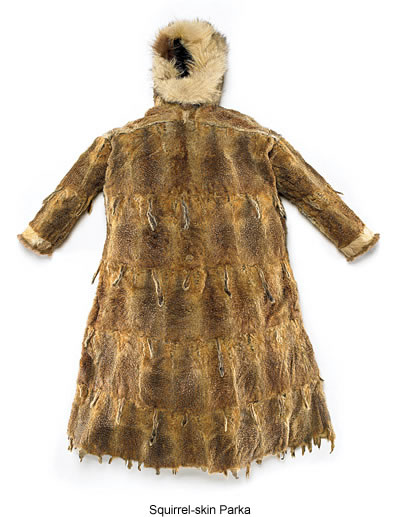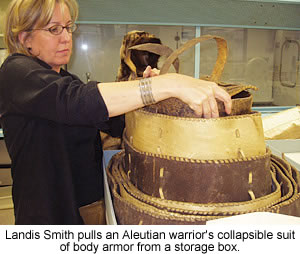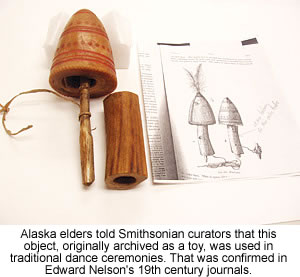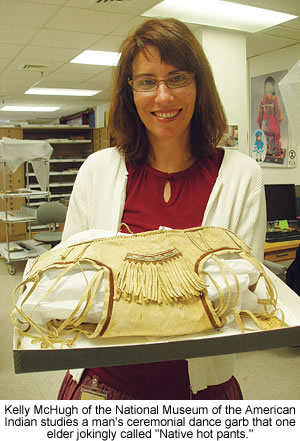 |
Canku Ota
|
 |
|
(Many Paths)
|
||
|
An Online Newsletter
Celebrating Native America
|
||
|
June 1, 2010 - Volume
8 Number 6
|
||
|
|
||
|
Smithsonian Arctic
Studies Center Restores Pieces Of The Alaska Native Story
|
||
|
by Fran Golden - Special
to The Washington Post
|
||
|
Paul Ongtooguk, an Iñupiag from the north of Alaska, said in an interview at the Anchorage Museum that he is looking forward to the "family reunion." The new Smithsonian Arctic Studies Center at the Anchorage Museum, opening May 22, will display clothing, baskets, masks, weapons, utensils, drums, games and more in a first-of-its kind permanent loan arrangement between the Alaska museum and the Smithsonian. As part of the unusual agreement, some Alaska Native community members such as Ongtooguk, one of the consultants on the project and an assistant professor of education at the University of Alaska at Anchorage, will be allowed to remove the objects, with assistance from curators, for further study and interpretation. The artifacts come from the National Museum of Natural History and the National Museum of the American Indian, where they've mostly been in storage. The initial agreement commits them to the Alaska museum for seven years. In choosing the objects, which represent nine native cultures across the state and date mostly from 1850 to 1900, Smithsonian anthropologists examined about 30,000 items in Washington. The effort was headed by Aron Crowell, director of the Arctic Studies Center, who has represented the Natural History Museum on the project since 1994. It was a daunting task, Crowell said when I interviewed him in Anchorage. But he and his colleagues had help. Beginning in 2002, 40 native elders, artists and educators, chosen by regional Alaska native organizations, made seven weeklong trips to Washington to go through thousands of items. Hundreds of other Alaska natives also had input into the project.
Crowell enthusiastically showed off the new space on a cold day in February. The delicate shipments had not yet arrived from Washington, but glass cases -- specially designed with armlike mounting brackets so that items can be removed and carted to a study area -- were in place and had him gleeful. Alaska native artists, elders, historians and others with expert knowledge will have access to the objects by appointment. Webcasting will allow those in remote locations to witness their interpretations of the items.
"This is not hands-off, and kept behind glass. It's a community resource and study collection, and we are thrilled to make use of it in that way," Crowell said. "That took a lot of negotiation." Many of the objects are fragile, and some needed repair before they could be exhibited.
In a far corner, an audio gallery, the Listening Space, will run a cycle of stories told in English and about 20 native languages. Ongtooguk said that for many of Alaska's more than 100,000 indigenous residents, the objects in the exhibit are already family. "We talk about these pieces in our families the same way we talk about relatives," he said. "These objects our like our great-grandparents that are being brought home again." Of particular interest to him is an Iñupiag bola, a throwing weapon made of weights on long strings. He said that an uncle had taught him to use a similar one to hunt ducks. "He thought I should know a traditional way to bring in food," Ongtooguk said. "You throw with your foot, legs, shoulders and arms and should hear a 'zoot' sound when it's released."
A parka made of seal gut, from the Yupik people of St. Lawrence Island in the Bering Sea, for instance, evoked from elder Estelle Oozevaseuk a story about the village of Kukulek, lost in an epidemic and famine in 1878-80. A recording of the story in both Yupik and English will play for visitors in the Listening Space. Rosita Worl, director of the Sealaska Heritage Institute in Juneau and a Tlingit consultant to the center, said that she felt an emotional, even spiritual connection to the objects. "It's important to our ancestors that they be viewed," she said. "In drawers, in Washington, no one ever sees them. To see them here is really significant." Golden is a Boston-based cruise and travel writer and co-author of "Frommer's Alaska Cruises & Ports of Call." The Arctic Studies Center at the Anchorage Museum, 625 C St. Open 9 a.m. to 6 p.m. daily, May 22 to mid-September, closed Mondays other times of the year. $10, $8 seniors, students and military, $7 ages 3 to 12. |
|
|
||
|
|
||
| Canku Ota is a free Newsletter celebrating Native America, its traditions and accomplishments . We do not provide subscriber or visitor names to anyone. Some articles presented in Canku Ota may contain copyright material. We have received appropriate permissions for republishing any articles. Material appearing here is distributed without profit or monetary gain to those who have expressed an interest. This is in accordance with Title 17 U.S.C. Section 107. | ||
|
Canku Ota is a copyright ©
2000, 2001, 2002, 2003, 2004, 2005, 2006, 2007, 2008, 2009, 2010
of Vicki Barry and Paul Barry.
|
||
 |
 |
|
|
The "Canku
Ota - A Newsletter Celebrating Native America" web site and
its design is the
|
||
|
Copyright ©
1999, 2000, 2001, 2002, 2003, 2004, 2005,
2006, 2007, 2008, 2009, 2010
of Paul C. Barry.
|
||
|
All Rights Reserved.
|
||
 A
$40 million Alaska Native collection is debuting in Anchorage this
month, representing a homecoming for 600 rare objects, most of which
have never before been seen in public, much less touched.
A
$40 million Alaska Native collection is debuting in Anchorage this
month, representing a homecoming for 600 rare objects, most of which
have never before been seen in public, much less touched.  The
participants were videotaped telling stories about the objects and
describing the memories they brought back, and these videos are
part of the exhibit, which is called "Living Our Cultures,
Sharing Our Heritage: The First Peoples of Alaska." The videos
will run continuously on large screens throughout the 10,000-square-foot,
second-floor gallery space in the Anchorage Museum's new wing, part
of a $106 million expansion at Alaska's largest museum.
The
participants were videotaped telling stories about the objects and
describing the memories they brought back, and these videos are
part of the exhibit, which is called "Living Our Cultures,
Sharing Our Heritage: The First Peoples of Alaska." The videos
will run continuously on large screens throughout the 10,000-square-foot,
second-floor gallery space in the Anchorage Museum's new wing, part
of a $106 million expansion at Alaska's largest museum.  Visitors
to the gallery will see a short introductory film before viewing
the displays, which are arranged geographically from the Tsimshian
people in the southeast to the Iñupiag people in the north.
Hands-on interactive screens similar to those at the American Indian
museum will allow visitors to zoom in on the objects and to get
more detailed commentary.
Visitors
to the gallery will see a short introductory film before viewing
the displays, which are arranged geographically from the Tsimshian
people in the southeast to the Iñupiag people in the north.
Hands-on interactive screens similar to those at the American Indian
museum will allow visitors to zoom in on the objects and to get
more detailed commentary.  Crowell
said that many of the other pieces also have deep meaning.
Crowell
said that many of the other pieces also have deep meaning.